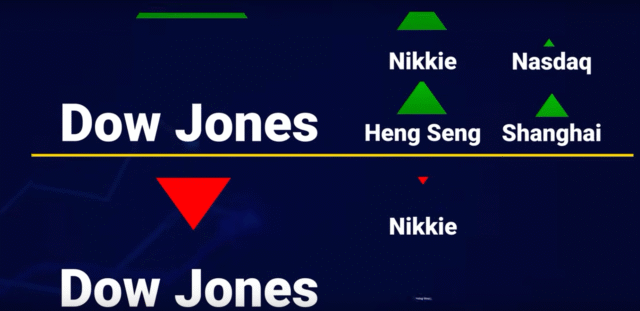U.S. markets saw a strong midweek rally on Wednesday, sparked by two major developments: encouraging inflation data and former President Donald Trump’s bold claim that a long-anticipated trade deal between the United States and China has been finalized.
The Dow Jones Industrial Average rose by 142 points, translating to a gain of around 0.3%, while the tech-heavy Nasdaq Composite outperformed with an increase of approximately 0.4%. Investors responded positively to the latest Consumer Price Index (CPI) data and hints of a thaw in U.S.-China trade tensions.
Encouraging Inflation Report Sparks Optimism
The U.S. Bureau of Labor Statistics released its May CPI report, and the numbers brought a sense of relief to Wall Street. The headline CPI rose 2.4% year-over-year, just under economists’ forecast of 2.5%. The core CPI, which strips out the more volatile food and energy prices, held steady at 2.8%, matching April’s pace.
Month-over-month increases were notably subdued, with both headline and core inflation rising by just 0.1%, undershooting projections. These figures are being interpreted as a sign that inflation is continuing to cool, potentially paving the way for interest rate cuts by the Federal Reserve later this year.
Trump Pushes for Aggressive Rate Cuts
Former President Donald Trump wasted no time jumping on the inflation report to pressure the Federal Reserve. In a Truth Social post written in all capital letters, Trump praised the CPI numbers as “great” and demanded a full 1% interest rate cut.
“CPI just out. Great numbers! Fed should lower one full point. Would pay much less interest on debt coming due. So important!!!” Trump wrote.
According to Trump, a significant rate cut would ease the federal government’s debt burden and pump more momentum into the U.S. economy. While the Fed remains independent, Trump’s public pressure echoes similar calls made during his presidency.
Fed Still Exercising Caution
Despite the improving inflation outlook, the Federal Reserve is in no rush to lower rates. The central bank has made it clear that it wants to see sustained disinflation before making any policy moves. Although many investors are betting on at least one rate cut by the end of 2025, Fed officials have repeatedly emphasized patience.
Still, market optimism is growing. Lower inflation gives the Fed more flexibility, and if the trend continues, the possibility of a policy shift becomes more realistic in the second half of the year.
Crypto, Risk Assets Could Benefit from Rate Cuts
A reduction in interest rates would likely weaken the U.S. dollar and lower bond yields, pushing investors toward riskier assets in search of better returns. One major beneficiary could be the cryptocurrency market, which tends to thrive in low-interest-rate environments.
Lower rates also increase liquidity across the financial system, meaning more capital could flow into sectors like tech stocks, startups, and digital assets. The overall effect is a more favorable environment for growth-focused investments.
Trump Claims U.S.-China Trade Deal is ‘Done’
Adding to the market enthusiasm was a dramatic claim from Trump, who declared on Wednesday that a U.S.-China trade deal is now finalized. This announcement followed two days of negotiations in London, where officials reportedly reached a “framework deal” aimed at easing long-standing economic tensions between the world’s two largest economies.
While Trump’s announcement created headlines, the agreement has not yet been formally signed. It still requires the approval of both Trump and Chinese President Xi Jinping. If ratified, the deal could prevent the reimposition of major tariffs that are scheduled to take effect on July 9.
From Escalation to De-escalation?
This progress comes just weeks after a tense breakdown in Geneva in May, where talks between the U.S. and China fell apart. In the aftermath, China restricted rare earth mineral exports—critical to industries like electronics and defense—while the U.S. cracked down on Chinese students with alleged links to the Chinese Communist Party.
The recent London talks appear to have calmed tensions. While the specifics of the agreement have yet to be disclosed, both sides are signaling a renewed willingness to cooperate, raising hopes that the trade war that once rattled global markets may finally be reaching a resolution.
What’s Next for Markets?
With inflation seemingly cooling and signs of a breakthrough in U.S.-China relations, investors are now closely watching two key players: the Federal Reserve and Xi Jinping.
Markets are hoping the Fed will respond to the inflation data with a more dovish stance, and that President Xi will formally approve the trade agreement. If both these developments go favorably, it could inject further energy into the markets, especially as earnings season approaches and global uncertainty persists.
Twin Boost for Wall Street
Market analysts say that Wall Street is currently enjoying a “double dose of good news”: on one hand, inflation appears to be slowing down, and on the other, geopolitical tensions between the U.S. and China seem to be cooling off.
These twin developments are lifting investor sentiment at a time when many had been bracing for continued volatility. Whether this rally has legs will depend on follow-through—both from the Fed and from Beijing.
Final Thoughts
The 142-point surge in the Dow Jones isn’t just about one day of trading gains—it’s a reflection of renewed optimism in the market. Trump’s declaration of a completed China trade deal and the unexpectedly soft inflation data are offering hope to investors who have been navigating uncertainty for months.
Of course, risks still remain. The Fed’s next move is far from guaranteed, the U.S.-China deal isn’t finalized yet, and global geopolitical tensions continue to loom large. But for now, the markets seem to have found a ray of hope, and investors are seizing the moment.










